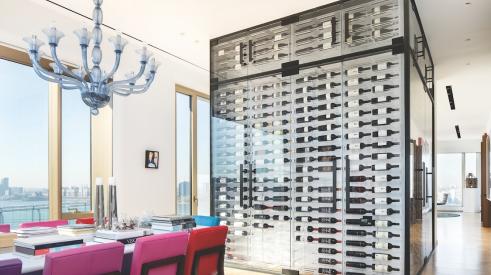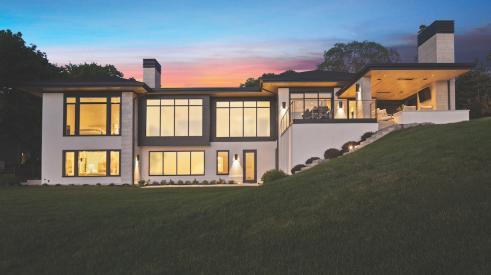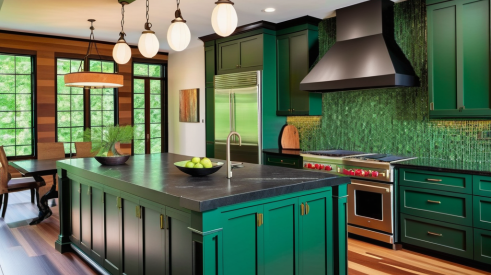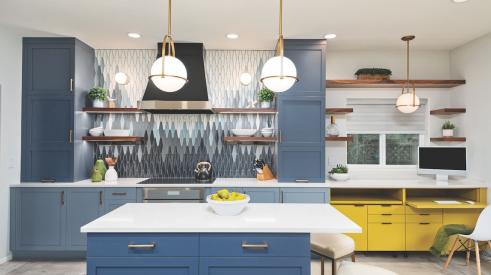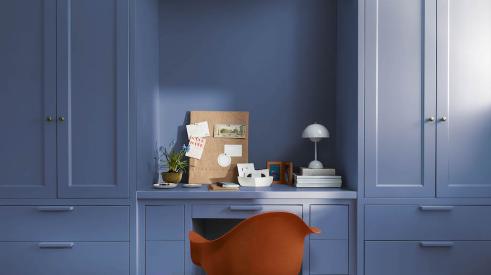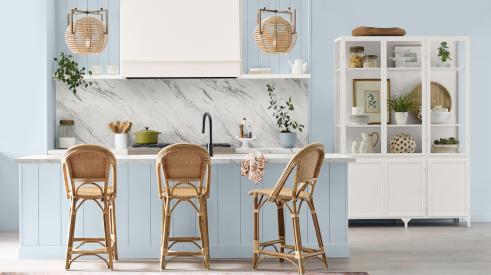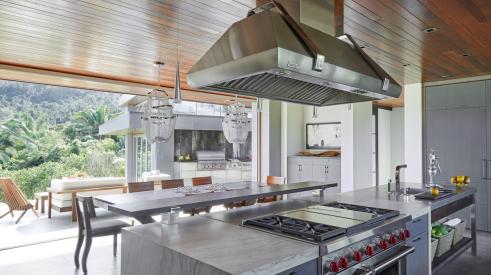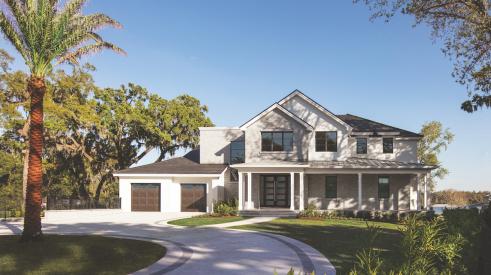|
An attractive business opportunity may be staring you in the face — the cabinet face, that is. More and more homeowners are determined to give their kitchens a new look, but kitchen remodels can be pricey, not to mention inconvenient for homeowners while the work is being done. Enter cabinet refacing, a faster, more economical yet equally stylish alternative. Once a specialty hovering on the fringe of remodeling, refacing is now a major contender in the industry.
Greg Ackley of Ackley Cabinet Remodeling, Ridgefield, Conn., has watched the refacing business come of age. "People had no idea that it existed in 1983," when he first offered refacing as an option, Ackley says. By the mid-1990s half his customers knew refacing was available. "Today everybody is aware" of it, he says, and refacing is in demand.
The increased demand has generated a bumper crop of low-budget, slap-on-a-veneer refacers, as well as do-it-yourself refacing products for homeowners looking for a quick and cheap update. But Ackley says refacing isn't just for penny pinchers; it has become the method of choice for more affluent clients as well. "People are willing to pay to have it done right," he says, by remodelers who deliver quality materials, fine craftsmanship and attention to detail. That includes use of a durable varnish finish instead of the less durable lacquer finish; use of select woods; the ability to add extras such as roll-out trays, tot-locks, lazy Susans; ability to provide extras such as trim, molding and extra cabinets; and good warranties.
Kitchen Tune-Up, an Aberdeen, S.D.-based cabinet remodeling franchise with some 300 franchisees around the country, has watched the quality refacing business rise markedly in the last decade. In 1995, 19 percent of the corporation's residential business was in refacing, with 72 percent in "restoration," a more basic process involving cabinet cleanup and hardware replacement. By 2003 restoration had dropped to 45 percent, and refacing had grown to 32 percent.
Gary Ellis had been a remodeler for two decades when he bought into the refacing action seven years ago. His Yarmouthport, Mass., architecture and building firm, Northside Building Co., was seeing a growing demand for high-quality, cost-effective kitchen turnarounds. Many houses in Northside's Cape Cod market have 1970s–80s kitchens with "very solid, ¾-inch plywood cabinet boxes" that stay in good shape for a long time because of their quality construction and can be reused. Ellis says. Refacing them can "make an old kitchen look like today's kitchen at half the price of new cabinets." To shorten the learning curve, take advantage of up to 40 percent material discounts and get name recognition, Ellis acquired a Kitchen Tune-Up franchise and opened it in 1997.
"We do 75 refacing jobs a year, twice as many as five years ago," says Ellis. "We could do two or three times more if we wanted" to hire more crews, he adds.
Contractors set up to do refacing jobs can offer a remodeling alternative to prospective clients that's attractive both financially and aesthetically. Many clients don't even need a complete kitchen makeover. Jerry Behrens, Kitchen Tune-Up vice president, says, "Clients who like their kitchen layout but don't like the cabinet door color and style are perfect candidates for refacing."
For remodelers, "the true beauty" of refacing, says Behrens, is that no plumbing is changed, no electrical systems are changed, and the flooring, drywall and counters aren't usually touched either. A typical refacing job, with about 32 cabinet and drawer openings, takes just two to four days in the house, according to Behrens, and that translates into big labor savings compared with a replacement project. Materials cost less too, of course. A new cabinet and door could run the contractor $200, says Behrens, while a new door costs $35–$100. All told, a refacing job might return a 40 to 50 percent gross profit, versus 30 to 35 percent for a cabinet replacement project, says Behrens.
The price of the job depends on the door material, style and size. Refacing the typical 32-opening kitchen using rigid thermal foil (RTF) doors averages $2,500 to $7,000, says Behrens. RTF is a surface that can be heated and pressed over medium-density fiberboard (MDF) panels, works well for doors with molding or a decorative profile and resists scratching.
Wood-veneer doors raise the price to the $4,000–$10,000 range. Ackley says a typical refacing job in his market runs $12,000 — still $10,000 less than a comparable replacement job — and includes a few extras such as two or three new cabinets, pull-out shelves and trash bins.
Refacing clients often request additional upgrades such as new molding, under-cabinet lighting, rollout trays, appliance fronts and fancy finishes. Jeff Dixon of I & E Cabinets, a full-service kitchen contractor in Paramount, Calif., says about half of I & E's projects are refacing jobs; the rest are cabinet replacements. "More often than not," he says, I & E refacing customers order a few new cabinets to round out their kitchen. In that case, I & E makes the boxes for the new cabinets and buys the doors from a custom door maker.
"Almost all professional refacers purchase new, custom-made doors from a door maker," says former remodeler and cabinet refacer Herrick Kimball, author of two books about refacing, Making An Old Kitchen New (Taunton Press) and The Successful Cabinet Refacer (Tradesman Publication). "There are several national companies that cater to refacers. Many also purchase readymade drawers, too."
Door manufacturers generally offer a warranty of five years with some extending that to 10 years or even lifetime. Hardware typically carries a lifetime warranty. Cabinet refacers may offer a longer warranty than the manufacturer does; Behrens says with good products most problems appear in the first five years if they appear at all and installers can offer a 1ifetime warranty without worrying. In other words, the lifespan of refaced cabinets is just as long as that of a new cabinet.
These days, the range of door styles and colors is just as wide for refacing as for new cabinets. "The selection of door styles and colors is three or four times greater than it was six years ago," says Ellis. Want one of the trendy dark woods or deep colors? You can get it. How about the hip new glazed doors, with white glaze on dark doors or brown glaze on white doors? No problem. "Anything you see in new cabinets, we can do in refacing now — for a fraction of the cost," says Ellis. And with the price of new kitchens on the rise, Ellis expects the demand for refacing to keep on growing.
| New Homes | Residential Remodeling | |
| Wood finish, raised panel in frame | 55% | 57% |
| Wood finish, flat panel in frame | 26% | 19% |
| Glass panel in wood frame | 1% | 3% |
| Laminate with raised panel look | 10% | 8% |
| Wood finish, flat panel with no frame | 1% | 5% |
| Laminate finish, flat panel with no frame | 7% | 5% |
| Other | 0% | 3% |
| Source: 2003 Assessment of Kitchen and Bath Materials in Residential Construction Based on: 2002 Annual Builder and Consumer Practices Reports, NAHB Research Center, Inc. For: National Kitchen and Bath Association |
||
|
The changing face of kitchen remodeling
Add new comment
Related Stories
This New Tech Turns Any Countertop into a Wireless Charger
FreePower for Countertop has swept awards for its innovation—and the company claims installing it is "as straightforward as cutting a sink"
Designing, Building, and Installing a Luxury Custom Wine Cube
An 11-foot wine cube enveloping a pantry is the stand out feature of this customized New York penthouse
Marvin Releases Switchable Privacy Glass Window
The privacy glass windows can be purchased from Marvin's Direct Glaze windows
Building A Small Projects Division from the Ground Up
Through hard work and careful strategy, Harth Home Services has seen big growth
Client Design Choices in the Time of Social Media and AI
Social media speeds up the trend cycles, and now artificially created images are falling into homeowners' hands
Design Trends to Watch in 2024
What’s in and out for the upcoming year? Remodeling designers share insights
Insights for Designing Outdoor Kitchens
Was the pandemic-fueled thirst for outdoor kitchen remodels and additions a fluke, or is it here to stay? Plus: The top design considerations for outdoor kitchens
Home Run Remodeling Lessons: The New American Remodel 2023
A final look at The New American Remodel 2023




